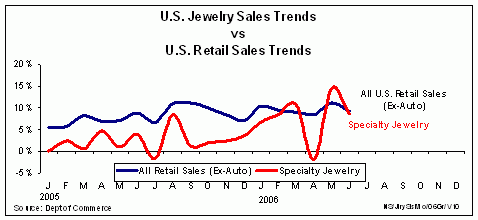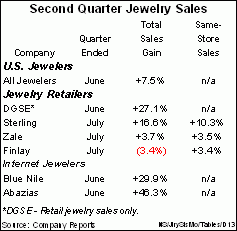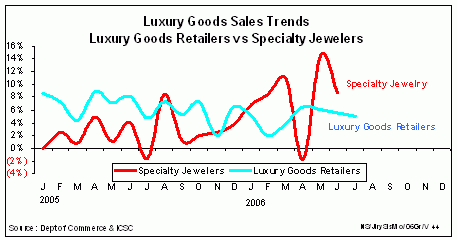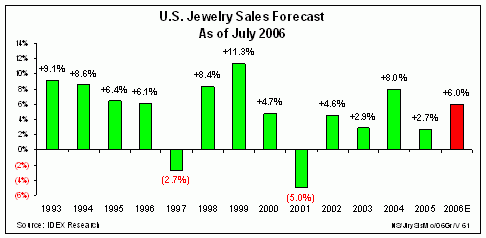IDEX Online Research: U.S. Jewelry Sales Strong in June
August 15, 06
There’s an old adage among retailers: “When the going gets hot, consumers go shopping.” That was the case in June, when jewelry sales rose by a solid 8.7 percent over June a year ago. The extreme heat over much of the
Despite the lack of a major sales event in June – aside from the usual graduation gifts of watches –

Continuing strong consumer demand in June helped pushed year-to-date
In addition to solid jewelry sales gains,
Jewelry Demand Is Broad-Based for Second Quarter
Among the major mass market retailers, Sterling Jewelers (Kay, Jared, and regional brands) reported the strongest sales gain – +16.6 percent – for the three-month period ended July 2006.
Zale’s quarterly sales gain of 3.7 percent – with a 3.5 percent same-store sales gain – was encouraging. This was the largest same-store sales gain since early 2005. However, the company announced that it would post a large loss in the July quarter due to one-time write-offs.
Finlay’s sales were also disappointing, with a total sales decline of 3.4 percent. However, its same-store sales advanced by +3.4 percent in going-forward units.
DGSE reported that its retail jewelry sales were up 27.1 percent in the June quarter. Total corporate revenues increased by 85.5 percent in the quarter, driven primarily by a 262 percent increase in bullion sales to $4.1million. Besides the 27.1 percent increase in retail jewelry sales, the company posted a 17.4 percent increase in wholesale jewelry sales and a 92.8 percent increase in the sale of rare coins.
Internet jewelry retailers also reported very strong sales in the second quarter. Blue Nile’s sales of $57 million – a 30 percent gain over last year’s June quarter – were driven primarily by greater diamond engagement sales, including seven customer sales above $100,000 and one sale above $200,000.
The following jewelers have reported sales results for the second quarter of 2006:

Mass market retailers such as J.C. Penney continued to report solid jewelry sales gains. For Penney’s second quarter ended July, company management cited fine jewelry as a particularly strong sales category for the company.
Luxury Goods Demand Remains Strong
In addition to strong demand for jewelry, American shoppers have continued to spend heavily on luxury goods, including leather goods (shoes, for example), and other high-end merchandise at up-scale retailers.
The graph below summarizes

Outlook: Economists See Clouds, But Consumers See Only The Rainbow
While retail analysts see stormy economic clouds on the horizon, consumers clearly have not gotten the message.
There are some positive factors driving consumer spending, including the following:
- Solid wage gains
- Relatively low interest rates
- Low unemployment
- Relatively low inflation
On the other hand, there are factors that are set to dampen consumer spending, including the following:
- Sharply higher energy prices
- High gasoline prices
- High consumer debt burden
- Weakening housing market
- Slowing job gains
- Geopolitical tensions remain
The good news is this: most analysts are calling for a slowing of the pace of retail consumption, not a collapse.
IDEX Online's Research’s Proprietary Jewelry Sales Forecast Still Positive
IDEX Online's Research’s proprietary jewelry sales forecast model for the
After weighing the negative factors – energy prices, gasoline prices, inflation threats, higher interest rates, and others – with the positive factors – wage and salary levels, low unemployment, and moderate inflation – our latest forecast suggests that
Intuitively, this seems somewhat aggressive based on the current economic outlook. Jewelers generate nearly 40 percent of their annual sales in October, November, and December. With storm clouds building on the horizon, the 2006 holiday selling season is highly uncertain. We’d be more comfortable with a jewelry sales forecast of about 4 percent for the year. Either way, a sales gain in the 4-6 percent for 2006 would be a solid gain that most jewelers would welcome.
